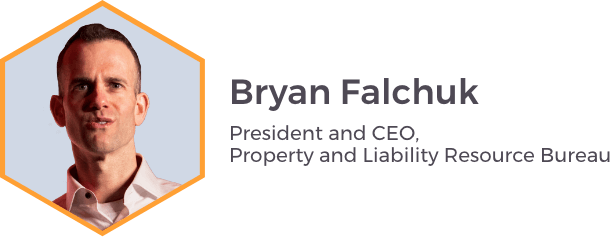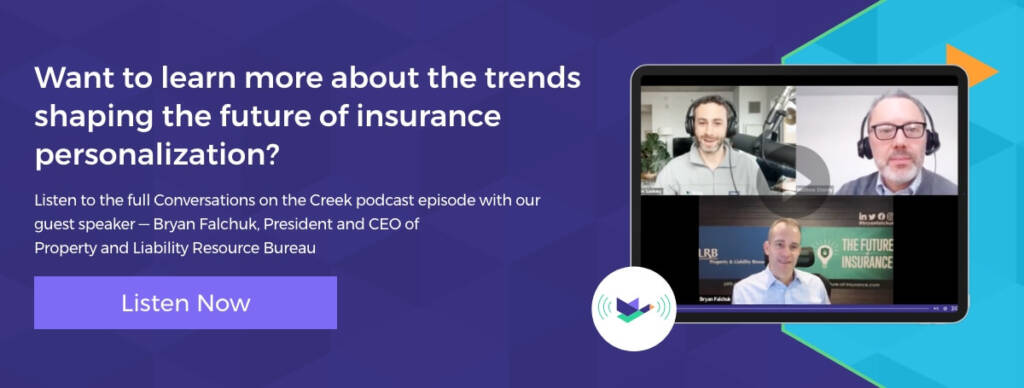Customers today demand the immediacy and personalization they experience with other industries, and insurers looking to defend their market position will need to make the right moves to meet their customers’ growing expectations.
In our recent Conversations on the Creek podcast episode, my colleague Mathew Stordy, Director of Technical Solution Consulting at Duck Creek Technologies, and I spoke with Bryan Falchuk, the author of The Future of Insurance: From Disruption to Evolution, Founder and Managing Partner of Insurance Evolution Partners, and President and CEO of Property and Liability Resource Bureau. We discussed the trends shaping the future of insurance personalization, and he revealed several key areas insurers should prioritize to transform their business and remain vital in the future. Below are excerpts from his interview (edited for readability). You can access the full podcast here.
1. Focus on building a seamless customer experience — go beyond tailoring coverage to customers’ needs
Bryan started off by defining what he thought true personalization is: “Delivering personalized insurance services is about more than just tailoring coverage to what you need – it’s about creating a frictionless customer experience that’s portable, dynamic, and fluid. After all, customized coverage isn’t a new concept and it’s more about delivering the right level of coverage than it is true product personalization. Plus, most carriers are offering it now anyway.
“To truly differentiate your P&C business through personalization, you will need to find a way to put more control in your customers’ hands. Personalizing experiences in insurance is about letting people interact with you the way they want to, be it served or self-served, and allowing them the choice of whether they want to engage with an agent or not, all of which need to be seamless. And with the industry’s shift to digital underway, there are many personalization tools in the market designed to help you deliver that.”
“When I have friends and relatives ask me, which carriers I like and who they should consider, I always remind them: ‘Even if it costs more, you’re really paying for the claims experience.’“

2. Improve the claims experience by enabling your customers to connect directly with you via text messaging
While most carriers today understand the value of text messaging in customer communication and optimizing the claims experience, they fall short in its implementation, Bryan observed.
“A lot of carriers are offering in-app texting or chat features, and in most cases, more things tend to go wrong than right because they haven’t factored in the customer’s experience. For example, is the app easy to navigate? Is the interface clunky and are the responses slow to load? Does everything work as expected when the customers are chatting with you?”
“I see folks who are claiming victory when what they’ve implemented is something that internally they’re very happy with themselves for, but externally, they haven’t really listened to their customers.“

Bryan stressed that as an insurer, your customers are already going through a difficult time in life, and your goal is to help them, not make them jump through extra hoops. This is why a simple and direct just-text-them approach can be more effective. Instead of forcing your customers to install and adapt to your insurer’s app, why not let your customers communicate with you directly via text messages (SMS)? It’s fuss-free, and it allows you to connect more intimately with the customer and offer them what they need at the right time – on a ubiquitous tool they already use in their everyday lives.
If you already have a texting capability in place, Bryan advises to start thinking about what to switch on next to ramp up personalization:
- Can you do sentiment analysis?
- Can you feed those texts into your decision engines?
- How can these real-time conversations inform your high-value business initiatives?
- Can you raise priority levels to redirect resources more effectively?
3. Leverage actionable insights from third-party data and AI-powered analytics to address elements that consumers value most
As customers’ reliance on IoT and smart devices continues to increase, so too does the volume of data that’s generated from these devices. Apart from personalizing P&C insurance products, Bryan reminds insurers that they can take advantage of data-derived analytics to create more value for customers through risk management and prevention.
He said, “In terms of property insurance, if people are going to continue building where we shouldn’t be building, we need to think about the types of decisions we can make proactively. As an industry, do we want to paint ourselves in a corner? Do we just label them as uninsurable and pull them out of these markets?
“To affect change requires a lot more precision in the kinds of recommendations and actions you would take, the kind of precision you can only gain through data analytics and AI. With the right tools, you can make better, faster decisions and design your products and services to work for your customers in a personalized way.”
At Duck Creek, we are seeing more innovation in insurers leveraging aerial imagery. This could help insurers not only predict and prevent losses, but be able to advise and provide customers with actionable steps they can take to mitigate risk, and overall, ensure more positive customer experiences.
Third-party data and AI-powered analytics is the competitive advantage you need to uncover new market opportunities.




